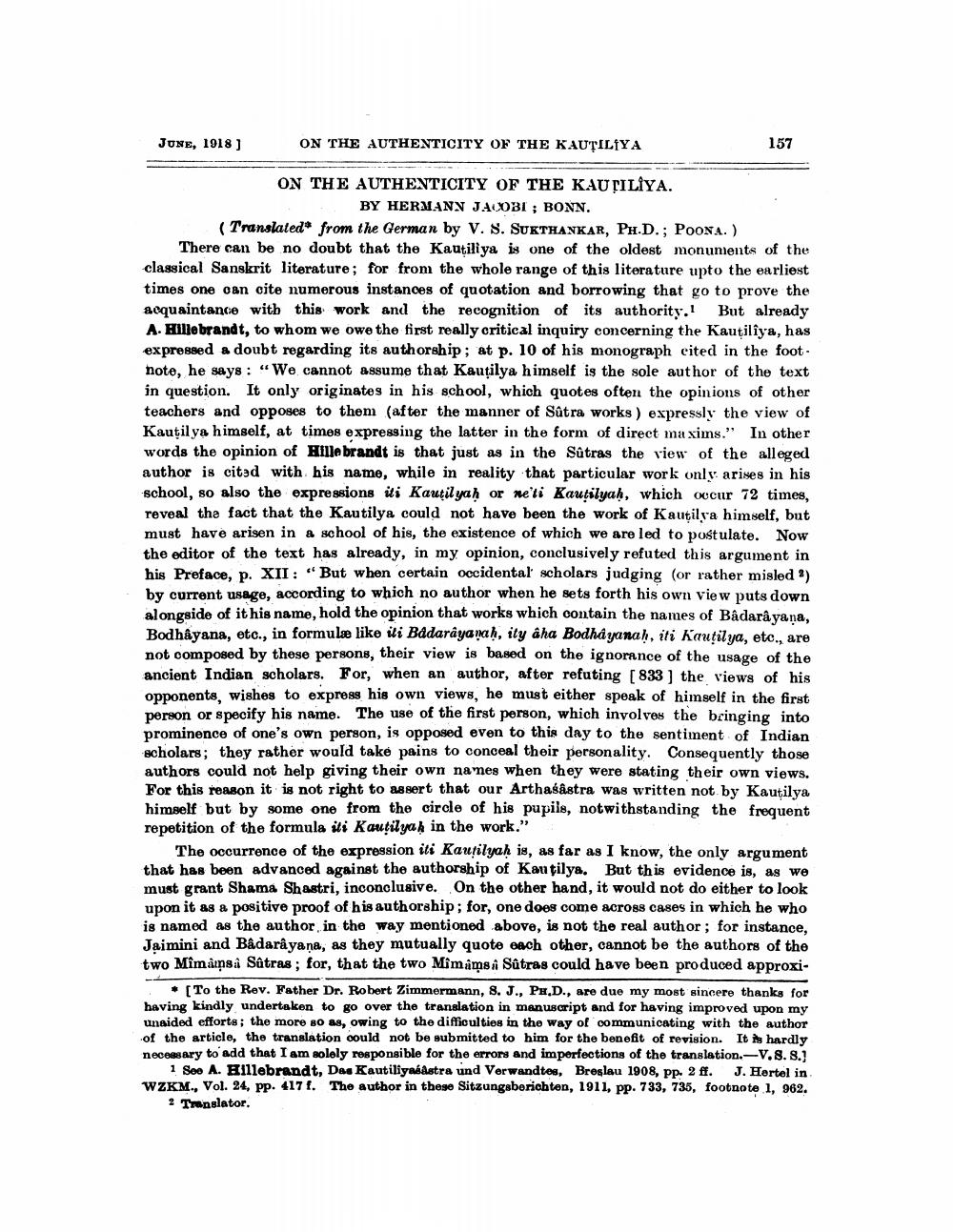________________
JUNE, 1918 ]
ON THE AUTHENTICITY OF THE KAUTILIYA
157
ON THE AUTHENTICITY OF THE KAUTILIYA.
BY HERMANN JACOB1 ; BONN. (Translated* from the German by V. S. SUKTHANKAR, PH.D.; POONA.) There can be no doubt that the Kautiliya is one of the oldest monuments of the classical Sanskrit literature; for from the whole range of this literature upto the earliest times one oan cite numerous instances of quotation and borrowing that go to prove the acquaintance with this work and the recognition of its authority. But already A. Hildebrandt, to whom we owe the first really critical inquiry concerning the Kauțilîya, has expressed a doubt regarding its authorship; at p. 10 of his monograph cited in the footnote, he says: “We cannot assume that Kautilya himself is the sole author of the text in question. It only originates in his school, which quotes often the opinions of other teachers and opposes to them (after the manner of Sûtra works ) expressly the view of Kautilya himself, at times expressing the latter in the form of direct maxims." In other words the opinion of Hillebrandt is that just as in the Sûtras the view of the alleged author is cited with his name, while in reality that particular work only arises in his school, so also the expressions iti Kautilyah or ne'li Kautilyah, which occur 72 times, reveal the fact that the Kautilya could not have been the work of Kautilya himself, but must have arisen in a school of his, the existence of which we are led to postulate. Now the editor of the text has already, in my opinion, conclusively refuted this argument in his Preface, p. XII: “But when certain occidental scholars judging (or rather misled?) by current usage, according to which no author when he sets forth his own view puts down alongside of it his name, hold the opinion that works which contain the names of Bâdarâ yana, Bodhayana, etc., in formulæ like ili Badarayanah, ity aha Bodha yanah, iti Kautilya, etc., are not composed by these persons, their view is based on the ignorance of the usage of the ancient Indian scholars. For, when an author, after refuting [ 833) the views of his opponents wishes to express his own views, he must either speak of himself in the first person or specify his name. The use of the first person, which involves the bringing into prominence of one's own person, is opposed even to this day to the sentiment of Indian scholars; they rather would take pains to conceal their personality. Consequently those authors could not help giving their own names when they were stating their own views. For this reason it is not right to assert that our Arthasastra was written not by Kautilya himself but by some one from the circle of his pupils, notwithstanding the frequent repetition of the formula iti Kautilyak in the work."
The occurrence of the expression iti Kautilyah is, as far as I know, the only argument that has been advanced against the authorship of Kautilya. But this evidence is, as we must grant Shama Shastri, inconclusive. On the other hand, it would not do either to look upon it as a positive proof of his authorship; for, one does come across cases in which he who is named as the author in the way mentioned above, is not the real author; for instance, Jaimini and Bådarayaņa, as they mutually quote each other, cannot be the authors of the two Mîmansa Satras ; for, that the two Mimams a Sûtras could have been produced approxi
To the Rev. Father Dr. Robert Zimmermann, 8. J., Ph.D., are due my most sincere thanks for having kindly undertaken to go over the translation in manuscript and for having improved upon my unaided efforts, the more 80 as, owing to the difficulties in the way of communicating with the author of the article, the translation could not be submitted to him for the benefit of revision. It is hardly necesary to add that I am aolely responsible for the errors and imperfections of the translation.-V.8. 8.)
1 Soo A. Hillebrandt, Da. Kautiliyasastra und Verwandtes, Breslau 1908, pp. 2 ff. J. Hertel in WZKM., Vol. 24, pp. 417f. The author in these Sitzungsberichten, 1911, pp. 733, 735, footnote 1, 962.
2 Translator.




